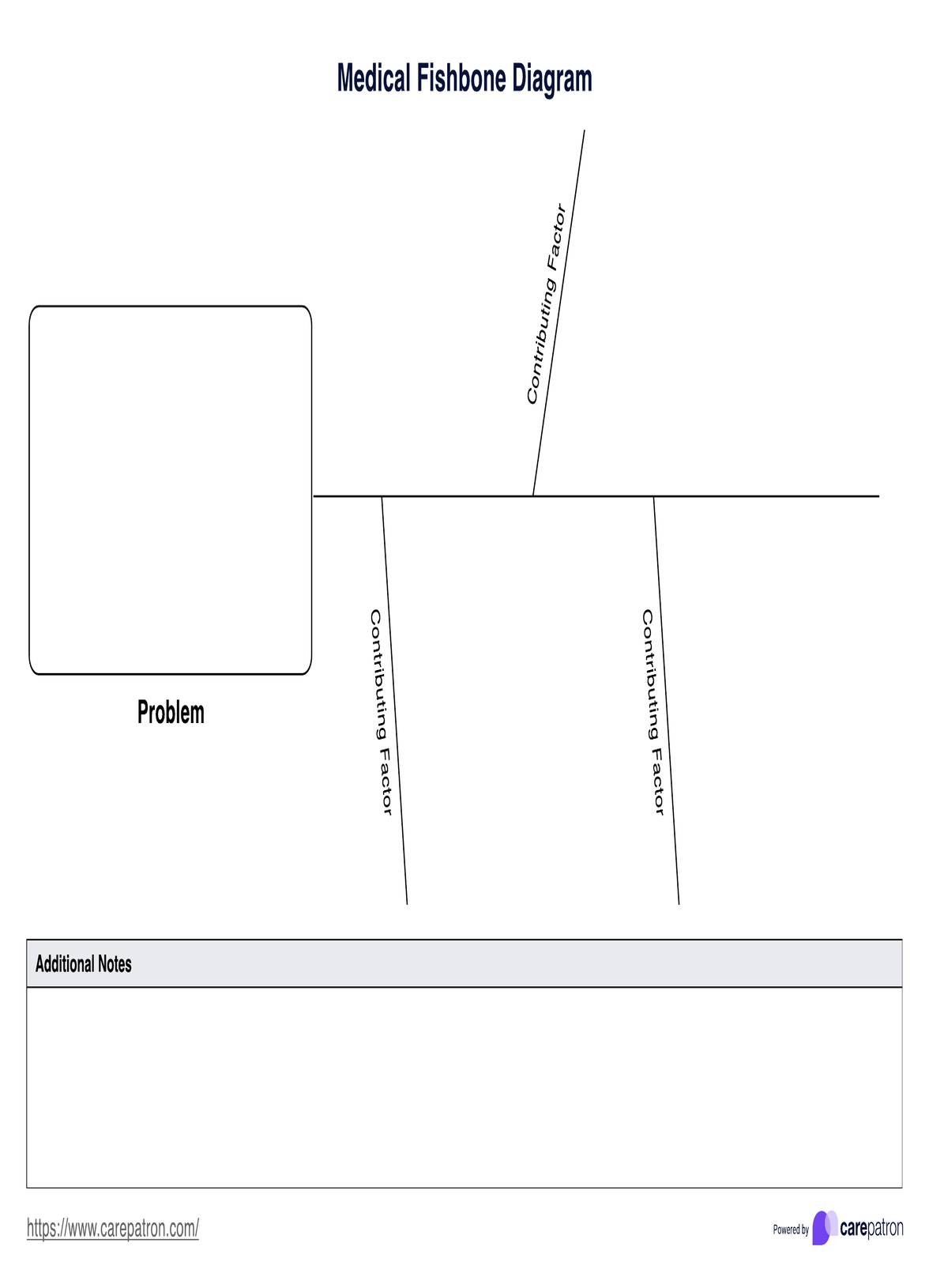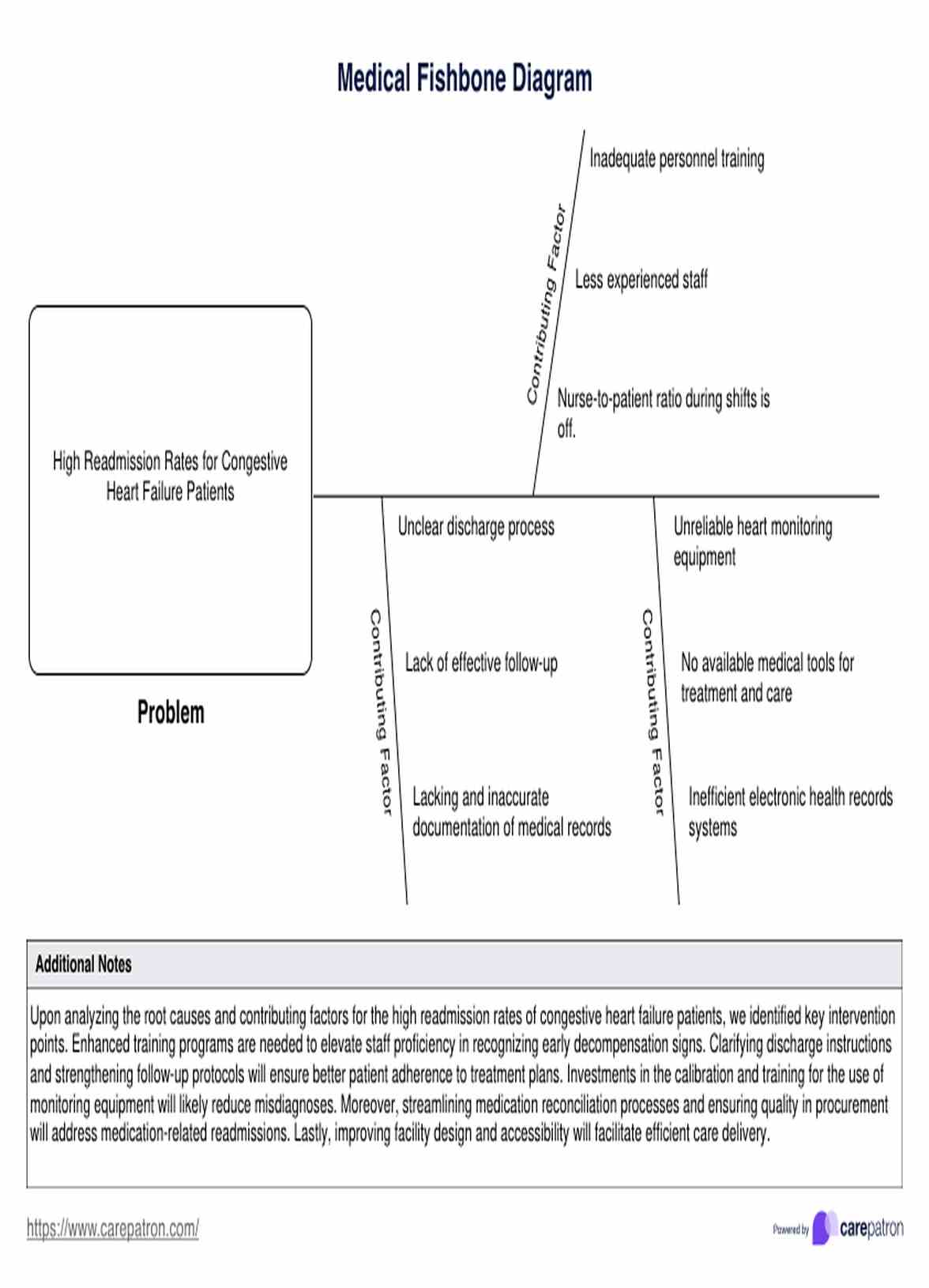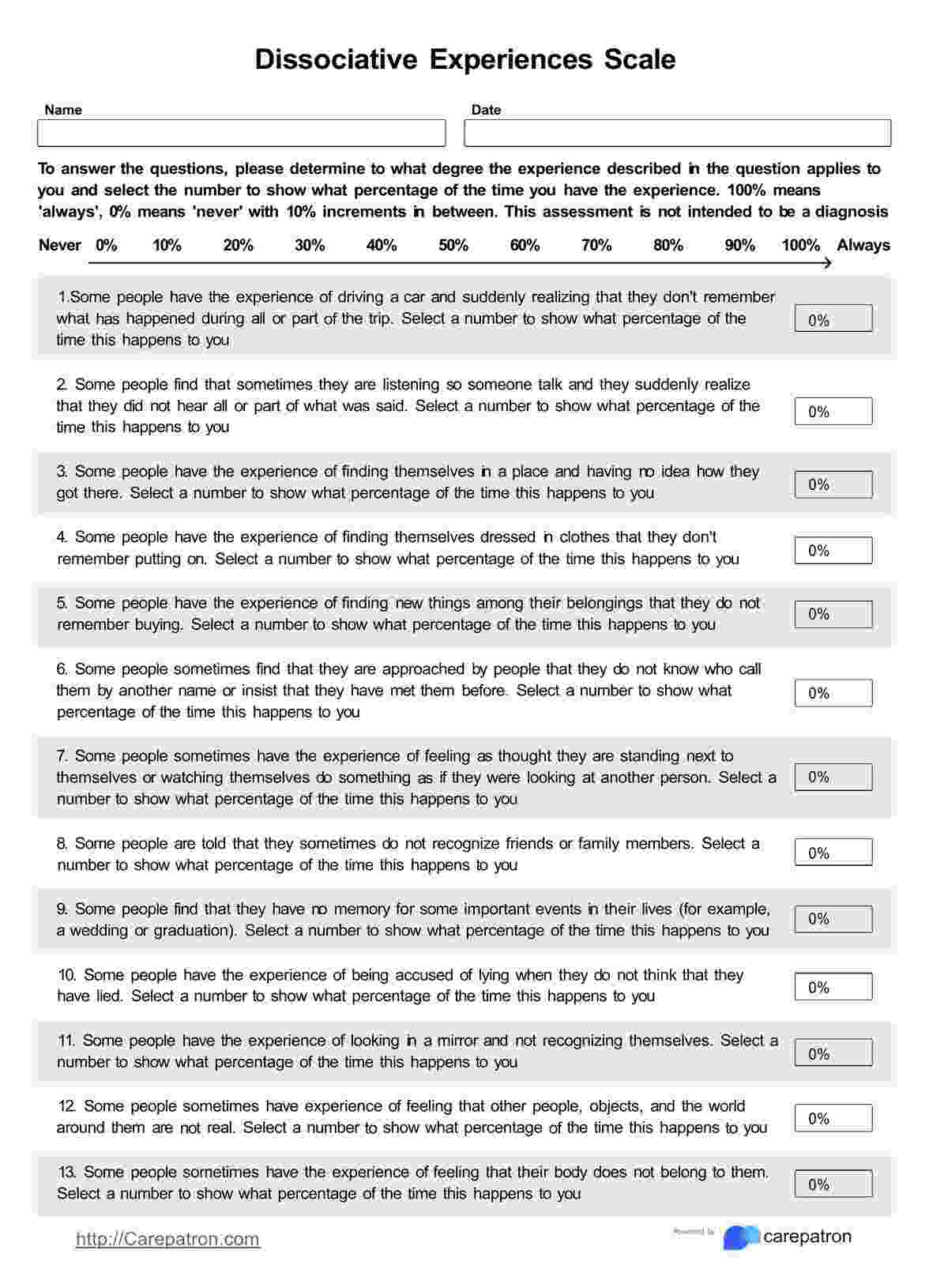Medical Fishbone Diagram
Explore the Medical Fishbone Diagram to identify the causes of healthcare issues with our free PDF template. Streamline problem-solving in clinical settings.


What is a fishbone diagram?
A Fishbone Diagram, also known as an Ishikawa diagram or a cause-and-effect diagram, is a visual tool used to systematically identify, sort, and display possible causes of a specific problem or effect. It helps to identify potential underlying issues by categorizing potential causes into major categories, which can vary depending on the context.
The diagram is called a "fishbone" because its shape resembles the skeleton of a fish, with a central "spine" and several branches representing different categories of root causes or contributing factors leading to the problem.
When is a fishbone diagram used?
Fishbone diagrams are ideal for situations where you have a complex problem and a lot of initial ideas about major cause of what might be causing it. Here are some specific times they come in handy:
- Brainstorming sessions: Fishbone diagrams help organize a team's initial thoughts on potential causes. Everyone can contribute ideas, which are then categorized logically for further discussion.
- Complex problems: For issues with many potential causes, a fishbone diagram helps you delve deeper into the root causes, not just surface-level solutions.
- Quality improvement projects: These diagrams help identify and document all the factors contributing to a problem, allowing for targeted interventions to improve quality.
- Before implementing solutions: Using a fishbone diagram ensures you've considered all possible causes before taking action. This helps you choose the most effective corrective steps.
By organizing and categorizing potential causes, fishbone diagrams promote a thorough analysis of problems. This leads to a deeper, better understanding of the root causes and, ultimately, more effective solutions.
Medical Fishbone Diagram Template
Medical Fishbone Diagram Example
When is the fishbone diagram used in the medical field?
Fishbone diagrams are a valuable tool for healthcare and health care professionals to tackle various challenges. Here are some key areas where they shine:
- Improving patient care: Fishbone diagrams can help identify the root causes of quality issues in patient care. This allows teams to develop targeted interventions for enhanced care delivery.
- Ensuring patient safety: Following a safety incident or near miss, these diagrams help analyze the event and pinpoint contributing factors. This knowledge is then used to develop strategies to prevent similar incidents in the future.
- Diagnosing complex conditions: Fishbone diagrams can organize and analyze potential contributing factors for patients with complex medical conditions, aiding in a more accurate diagnosis.
- Boosting operational efficiency: Fishbone diagrams can help healthcare teams identify and address inefficiencies in everyday operations, such as delays in patient discharge or medication errors.
By promoting a structured approach to problem-solving, fishbone diagrams empower healthcare professionals to improve patient care, enhance safety, and optimize healthcare delivery.
How is the fishbone diagram used in the medical field?
Fishbone diagrams are powerful tools for healthcare professionals to pinpoint the root causes of problems. Here's how they work:
- Define the problem: Start by clearly stating the issue you want to address. Is it a rise in medication errors, high patient readmission rates, or inefficient appointment scheduling? Write this problem statement at the "head" of the fishbone diagram.
- Build the fishbone: Draw a horizontal line as the "spine" of the fish. Branching off this line at an angle, draw main categories that might contribute to the problem.
- Brainstorm causes: For each category, brainstorm specific factors that could be causing the problem. This is where teamwork shines! Include a diverse group of healthcare providers to capture various perspectives.
- Analyze and prioritize: Don't stop at listing everything! Analyze the brainstormed causes to identify the most likely culprits. Consider factors like frequency, severity, and available data.
- Develop solutions: Finally, use the identified root causes to develop action plans. This might involve staff training, implementing new workflows, or acquiring new equipment.
By following these steps, healthcare teams can effectively create and leverage fishbone diagrams to troubleshoot and improve patient care and overall operational efficiency.
What can you expect to see in a Medical Fishbone Diagram?
The fishbone diagram helps identify, explore, and display the root causes, contributing factors, and problems with fish bones. Here’s a detailed look at the essential components of a Medical Fishbone Diagram:
Problem statement
The problem statement is the focal point of the Fishbone Diagram and is usually placed at the head of the fish, with the fishbone diagram's spine leading to it. This statement should clearly and concisely describe the issue being addressed.
In a medical context, this could be a specific patient safety concern, a frequent clinical diagnostic error, or any undesirable outcome in patient care. The problem statement serves as the endpoint to which all diagram branches contribute, effectively summarizing the effect or issue the analysis aims to resolve.
Root causes of the problem
Root causes are the underlying factors that contribute directly to the problem. These are typically identified through brainstorming sessions and are placed along the main branches or "bones" stemming from the diagram's spine. In the context of healthcare improvement, root causes can be categorized into various domains, such as:
- Personnel: Staff-related factors, such as training, skill levels, or staffing ratios.
- Procedures: Clinical and administrative processes or guidelines that are inadequate, outdated, or incorrectly followed.
- Equipment: Issues with the medical or technological equipment used in patient care, including availability, maintenance, and functionality.
- Materials: Concerns about the supplies and medications used, such as their quality, availability, or storage conditions.
- Environment: Physical or organizational work environment issues that affect the quality of care or staff performance.
Identifying root causes requires a deep dive into the systemic issues that lead to the problem, looking beyond the immediate or superficial to define and identify root causes.
Contributing factors
Contributing factors are secondary causes that, while not directly causing the problem, influence its occurrence or severity. These are often found along the smaller branches or "fishbones" that stem from the main categories of root causes. In healthcare and medical education, contributing factors might include:
- Communication: Breakdowns or lapses in communication among healthcare providers or between providers and patients.
- Culture: Organizational culture aspects that might discourage reporting errors, asking for help, or adhering to best practices.
- External factors: Regulatory changes, insurance policies, or other external pressures that affect clinical practice.
- Patient factors: Patient-specific factors include comorbidities, non-adherence to treatment plans, or unique vulnerabilities.
It is essential to identify contributing factors because they often represent areas where small changes can significantly improve outcomes or prevent the problem.
How does our Medical Fishbone Diagram template work?
Our fishbone diagram templates provide a structured method for healthcare professionals to analyze and visualize the root cause of medical issues. It's crafted to facilitate a systematic approach to problem-solving in clinical settings. Here’s how to use our template:
Step 1: Download the template
Begin the process by downloading a copy of our template from our website. The template is free in various formats, catering to different preferences, whether you like working digitally or prefer a physical copy. Ensure you have the appropriate software to open and edit the template to customize it digitally.
Step 2: Customize according to the specific medical issue
Tailor the template to the particular medical issue or problem you're addressing. The template is designed to help you categorize potential causes into main categories such as personnel, procedures, equipment, and environment. Adapt these categories based on the nature of the problem and the specific context of your healthcare setting.
Step 3: Explain how it works to your team
If you're using this template within a team or with colleagues, it is crucial to ensure everyone understands how to interpret and contribute to it. Guide them through each section, emphasizing the importance of identifying the root cause and any contributing factors. This step is essential for fostering a collaborative problem-solving environment.
Step 4: Identify and list potential causes
Use the template for a brainstorming session and list all possible causes of the problem, placing them under the appropriate categories. Encourage team members to contribute their insights and perspectives to ensure a comprehensive analysis. This collective approach enhances the depth and breadth of the root cause analysis.
Step 5: Analyze and prioritize issues
With all potential causes listed, the next step involves analyzing them to identify which are most likely contributing to the problem. This might require additional data collection or consultation with experts. Prioritize the issues based on their impact and the feasibility of addressing them, focusing on interventions identified causes that offer the greatest potential for improvement.
Step 6: Develop and implement action plans
Develop action plans to address the root causes based on the diagram created. This might involve procedures, training, equipment, or environmental changes. Implement these plans in a structured manner, monitoring their impact and adjusting as necessary.
What are the benefits of using the fishbone diagram in medicine?
Fishbone diagrams are powerful tools for healthcare and medical professionals, offering several key benefits:
- Deeper problem-solving: They visually break down complex problems, helping teams grasp the root causes more effectively.
- Enhanced collaboration: By encouraging input from everyone, fishbone diagrams foster teamwork and lead to more comprehensive solutions.
- Targeted solutions: These diagrams help identify the root causes, not just symptoms, leading to more effective and long-lasting improvements.
- Prioritized action: Teams can prioritize issues based on impact and feasibility, optimizing resource allocation and achieving quicker results.
- Improved diagnosis and treatment: Fishbone diagrams can streamline diagnosis by organizing and evaluating potential causes of patient symptoms.
By leveraging these benefits, fishbone diagrams empower healthcare professionals to have creative thinking to tackle challenges, improve patient care, and cultivate a culture of continuous improvement.
Commonly asked questions
By identifying the underlying causes of healthcare issues, Medical Fishbone Diagrams can help teams implement targeted solutions, ultimately improving patient care, quality management, and safety.
The main limitation of Medical Fishbone Diagrams is that they require accurate identification of causes and contributing factors, which can be challenging without sufficient data or if biases influence the analysis.
Yes! While they are instrumental in healthcare, Fishbone Diagrams can be adapted to analyze and solve problems in various fields such as business, engineering, and health care, research, and education.

























-template.jpg)
























































































